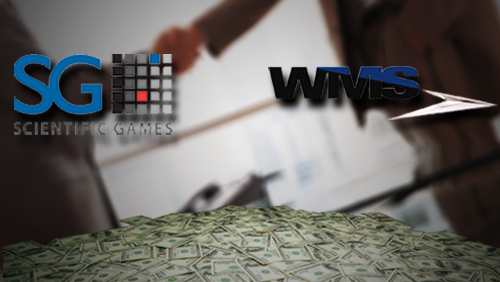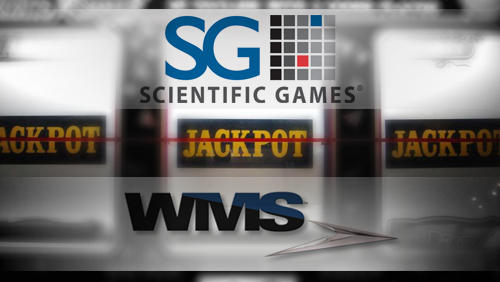One more and it’s a trend. A little more than a month after Pinnacle Entertainment (PNK) acquired Ameristar Casinos (ASCA) for $869 million, Scientific Games pulled off a blockbuster of its own, buying out slot machine manufacturer WMS Industries (WMS) for $1.42 billion on Thursday.
 Scientific Games is paying $26 per share for WMS (and assuming a modest $30 million in net debt) in a deal that has to be somewhat bittersweet for WMS shareholders. Yes, the purchase price represents a lofty 59% premium to WMS’ Wednesday close. But the $26 price is only a few percentage points above where WMS traded as recently as May 2012, and barely half of the $50 per share levels the company reached in 2010. Still, given the company’s recent performance – revenue fell sharply in fiscal 2012, as did earnings – the buyout offer was a nice surprise for WMS shareholders. It also seems highly unlikely that another buyer will step forward; according to Barron’s, in the wake of the announcement,JP Morgan put out a note dismissing the idea of additional bidders given the “premium valuation” assigned to WMS. Furthermore, WMS stock closed Friday at $24.69, a 5 percent discount to SGMS’ offer, which reflects apparent fears that the deal may fall apart at some point. Such fears seem unlikely; SGMS has already lined up financing in the form of a seven-year term loan, according to the conference call discussing the acquisition, and regulatory difficulties should be limited given the lack of competitive overlap between the two companies. But the discount itself shows a lack of faith in a second, higher bid for WMS’ assets. Indeed, Ameristar actually traded above its own buyout price of $26.50 per share after the Pinnacle bid was announced, as speculators hoped for a potentially higher offer from MGM Resorts International (MGM) or another suitor. (ASCA has since faded to $26.38 per share.)
Scientific Games is paying $26 per share for WMS (and assuming a modest $30 million in net debt) in a deal that has to be somewhat bittersweet for WMS shareholders. Yes, the purchase price represents a lofty 59% premium to WMS’ Wednesday close. But the $26 price is only a few percentage points above where WMS traded as recently as May 2012, and barely half of the $50 per share levels the company reached in 2010. Still, given the company’s recent performance – revenue fell sharply in fiscal 2012, as did earnings – the buyout offer was a nice surprise for WMS shareholders. It also seems highly unlikely that another buyer will step forward; according to Barron’s, in the wake of the announcement,JP Morgan put out a note dismissing the idea of additional bidders given the “premium valuation” assigned to WMS. Furthermore, WMS stock closed Friday at $24.69, a 5 percent discount to SGMS’ offer, which reflects apparent fears that the deal may fall apart at some point. Such fears seem unlikely; SGMS has already lined up financing in the form of a seven-year term loan, according to the conference call discussing the acquisition, and regulatory difficulties should be limited given the lack of competitive overlap between the two companies. But the discount itself shows a lack of faith in a second, higher bid for WMS’ assets. Indeed, Ameristar actually traded above its own buyout price of $26.50 per share after the Pinnacle bid was announced, as speculators hoped for a potentially higher offer from MGM Resorts International (MGM) or another suitor. (ASCA has since faded to $26.38 per share.)
For SGMS shareholders, the potential benefits – and the potential risks – of the deal are readily apparent, as the stunning movement in the stock over the last two days showed. SGMS issued a press release at 7:30 am on Thursday announcing the deal; by the time the market opened at 9:30 am, the stock had risen 12 percent. It would reach an intraday high of $10.88, 22 percent above Wednesday’s close of $8.93. By day’s end, however, SGMS would actually trade below its previous close, finishing at just $8.89. The stock then jumped 6 percent in trading Friday, as the market decided that maybe it did like the purchase after all.
The reasons for the whiplash-inducing two-day ride are somewhat clear: this is a high-risk, high-reward transaction for Scientific Games. On the conference call discussing the acquisition, Scientific Games CEO Lorne Weil was extremely optimistic about the tie-up, noting two key factors that would make the acquisition worthwhile. First, Scientific Games has reported net losses for each of the last four years, despite creating positive cash flow, because of technical accounting reasons related to its revenues, which is predominantly generated overseas. Adding WMS – a consistent profit generator – will allow Scientific Games to use those losses – known as NOLs, or “net operating loss carryforwards” – to lessen tax burden on future WMS profits.
But, more importantly, Weil noted, WMS is a “mirror image” of Scientific Games. While SGMS largely derives its revenues from international channels, 75 percent of WMS business comes from the US, according to Scientific Games CFO Jeff Lipkin. Weil noted that SG’s “tremendous footprint” overseas would act as a built-in marketing channel for WMS’ machines and intellectual property. “We are very confident that this footprint can be extremely helpful to WMS in expanding the scope of its business in some of these geographies,” Weil told listeners. He later pointed out that many international lottery operators – nearly all of whom are SG partners – were “expanding their business into the gaming machine space,” pointing to Greek operator OPAP SA (OPAP.GA) as just one example. Another can be seen in Illinois, where Scientific Games has a contract to monitor and control thousands of video lottery terminals (VLTs). Given Scientific Games’ close relationship with those lottery operators, WMS would have an inside track toward becoming a supplier as those lotteries moved into VLT or slot machine businesses.
In addition, Weil emphasized that Scientific Games and WMS were not competitive with one another. In distinct contrast to the Pinnacle-Ameristar merger – in which one land-based casino operator swallowed another with several directly competing properties – SG and WMS are, Weil pointed out, “very complementary.” “We and WMS in almost no way and in almost no instance are competitive with each other,” he added. While both companies manufacture slot machines – 18 percent of SGMS’ trailing twelve-month revenue came from the “Gaming” segment – they target vastly different markets. WMS is a more traditional supplier to casinos; Scientific Games, on the other hand, does its business primarily in Europe, for pubs and bingo halls, in thousands of locations with often just 2-5 machines apiece. SG, for instance, has 30,000 machines in the UK, all running on a single country-wide server, an example cited by Weil as the move “more and more to a systems-centric model,” a model that could boost WMS’ development going forward. Meanwhile, the two companies’ interactive divisions – SciPlay for SGMS, Williams Interactive for WMS – can similarly take advantage of cross-selling between SciPlay’s predominantly lottery-based B2G customer base and Williams Interactive’s B2C social and mobile gaming platforms (notably its Jackpot Party Casino app on Facebook).
All told, the deal is designed to take advantage of the increasing convergence being seen across the gambling industry, as the lines between lottery and gambling, between interactive and land-based, and between customer and supplier slowly blur. And the ability of SG and WMS – which, according to Weil, will likely remain relatively separate, as “Lottery” and “Gaming” segments – to cross-sell through each other’s channels to each other’s geographic and demographic markets offers a lot of promise for the combined entity.
There are risks of course. Neither company has performed particularly well of late; before the deal was announced, both stocks were actually trading below their share prices from March 6, 2009, the bottom for the S&P 500 amidst the 2008-09 financial crisis. (Since that date, the broad market has better than doubled, while gambling stocks as a group have nearly tripled.) WMS has been losing market share in the US and abroad, while SG has struggled to expand its interactive business in the US despite the optimism created by the December 2011 Department of Justice opinion regarding the 1961 Wire Act. Putting two struggling companies together and expecting the sum to outperform their parts – as compelling as the narrative of the merger has been – seems excessively optimistic, at the least. Weil himself noted on the call that “we’re well aware of the fact that as often as not these kinds of exercises don’t necessarily work out as successful as everybody hoped.”
Another key concern is the newly merged company’s debt. According to a presentation issued by Scientific Games, the combined entity will have debt of some $3.1 billion, relative to revenues of just $1.6 billion and SGMS’ current market capitalization of about $800 million. And while WMS has posted positive earnings per share as of late, its cash flow has been mediocre; in fiscal 2010, 2011, and 2012 combined, the company generated less than a million dollars’ worth of free cash. If the combined company cannot create organic revenue growth, interest expense will likely overwhelm its profits and its cash flow, as it has for other high-debt operators.
All told, the merger sounds great in theory; but it will all come down to execution. And given the fact that both companies have seen revenue declines in their most recent year, and both companies have seen their stock prices lag both their competitors and the broad market over the last five years, skepticism is certainly warranted. What is clear – and is evidenced by the movement in SGMS on Thursday and Friday – is that the combined company will likely have a more volatile share price, as its larger size, higher debt load, and increased market penetration create a wider range of potential outcomes. If the two businesses are truly as complementary as their executives claim, the merger could be a boon to both the lottery and slot machine businesses, and the new SGMS’ share price will take off. But if both segments continue to struggle, a long-term restructuring or even bankruptcy could take place once the merger’s tax benefits begin to wane. How it will turn out remains to be seen but, right now, SGMS stock is clearly a gamble.
